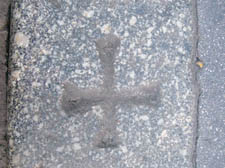| |

One of the kerb markings |
Crosses in the square mystify the experts
Art student maps Soho’s intriguing kerb markings
JEEVES doesn’t have a clue, archaeologists at the British Museum are stroking their chins, and university historians have drawn a complete blank.
Indiana Jones is unavailable, but so far the only explanations for the mysterious crosses on the kerbstones in Soho Square are as much fiction as George Lucas’s whip-cracking hero.
Art student Lauren Drescher spotted a crudely carved cross in one of the kerbstones when she was walking through the historic square last year.
On closer inspection, crosses appeared under almost every footstep – numbering 47 around the perimeter of the square – each one different from the next.
She presumed the explanation was a mere mouse-click away.
But after exhausting the internet, the Soho Society, the British Museum, the Museum of London, Westminster Archives and the Worshipful Society of Freemasons, she remained none the wiser.
Ms Drescher, 46, said: “The only real explanation I’ve had is that they’re masons’ marks but that just doesn’t seem to add up. Any cut in stone can be referred to as a mason’s mark – it’s too facile and masons’ marks are usually much more ornate.
“Plus a lot of the stones have more than one cross on them. In fact the Masons’ society have told us they’re not masons’ marks so that rules that out.”
Soho Square was built on the land formerly known as Soho Fields in the 1690s. As a result of the “drift” from more established parts of London ravaged by the great plague and fire of London in 1665 and 1666 Soho saw a population explosion.
Ms Drescher has been exploring her own theory that the kerbstones – many of which are the originals – were carved into as gravestones to commemorate the hundreds of thousands of people who fell victim to the pestilence.
“The markings do appear religious in nature and are reminiscent of gravestones,” she said.
“There are Maltese crosses, dotted crosses, rectangular crosses and ones with arrows. When a fifth of London’s population was wiped out in the plague and fire just around the corner, the corpses were dumped in mass pits and unmarked graves.
“Families of the newly dead who had moved into the area and were quarantined may have tossed out a coin to street urchins offering to memorialise the dead. I think they were possibly carved by the poor and destitute to earn a crust.”
The West End Extra spoke to the British Museum and the Museum of London and neither scholarly institution had an answer, although they were both very interested in Ms Drescher’s research.
The native New Yorker and trained midwife has written a research paper on the kerbstones and her map of cross locations is now on display at the Museum of London. She hopes someone will will come forward and corroborate her theory.
“To have uncovered an unexplained mystery on the streets of London has been a discovery in itself. I just hope someone out there knows what they are. As the history of the marks is still a mystery, preserving them should be a priority.” |
 |
|
 |
Your comments:
I NOTICED these crosses to last night whilst at work in Connaught Square W2. They appeared directly infront of each house front door which may support your theory. The square is also close to the famose tyburne tree where people were hung in London so could be linked to the dead? Hope this helps.
P. Taylor
|
| |
| |